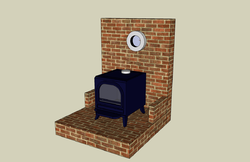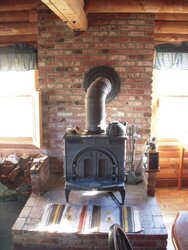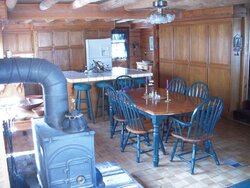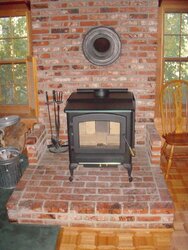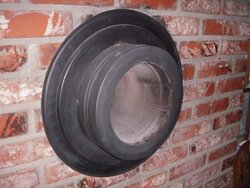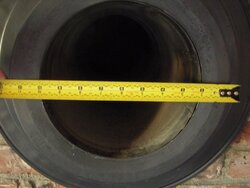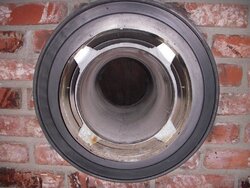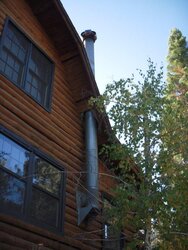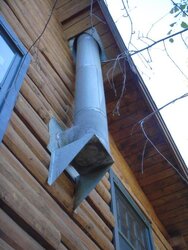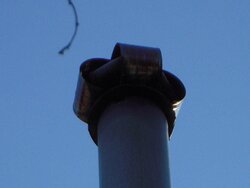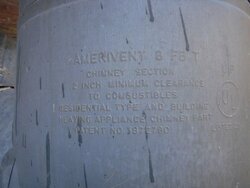I have posted a couple times trying to figure through this, but keep coming up with questions. I am hoping I can finally order some stove pipe soon!
Recap: I just put in place my new Englander 30. (Sorry, I didn't take any photos yet, but the drawing should be sufficient for the questions). It has a 6" flue and I need to attach to an 8" thimble. My clearances allow for single wall pipe. I would like to use Heat Fab. The stove is placed on the hearth directly in-line vertically with the thimble. It is 9 inches from the brick wall. Two options have been suggested by forum members, but I have questions with both options still, and can't decide if there is a "best" option.
Option #1: 6" X 12" pipe coming out of the flue, into a 90 degree elbow, into a 6" x 24" pipe that goes into the 8" thimble and protrudes an inch into the vertical flue of the chimney. Insulate with "rock wool" around pipe in thimble. Add a 6" trim collar.
Question: The 6" Heat Fab trim collar has an outside diameter that is greater than the outside diameter of the thimble. So, the collar will hang over on the sides of the thimble which I don't think will look great. If I use a trim collar from another manufacturer, will the Heat Fab pipe potentially not fit through the collar from another manufacturer? Other ideas on this?
Option #2: 6" x 12" pipe coming out of the flue, into a 90 degree elbow, into a 6" to 8" increaser that fits into the thimble.
Question: How would the increaser attach to the thimble? There doesn't appear to be any way to screw it onto the thimble. Is it safe to simply push the crimped end into the thimble and not positively attach it? How do I attach this safely and securely?
Any thoughts on which option is better? My #1 priority (after safety, obviously), is ease of disassembly/reassembly and cleaning of the stove pipe. Which actually brings me to my last question: The Heat Fab 90 degree elbows are corrugated. Are these difficult to clean?
Thanks in advance,
Bill
Recap: I just put in place my new Englander 30. (Sorry, I didn't take any photos yet, but the drawing should be sufficient for the questions). It has a 6" flue and I need to attach to an 8" thimble. My clearances allow for single wall pipe. I would like to use Heat Fab. The stove is placed on the hearth directly in-line vertically with the thimble. It is 9 inches from the brick wall. Two options have been suggested by forum members, but I have questions with both options still, and can't decide if there is a "best" option.
Option #1: 6" X 12" pipe coming out of the flue, into a 90 degree elbow, into a 6" x 24" pipe that goes into the 8" thimble and protrudes an inch into the vertical flue of the chimney. Insulate with "rock wool" around pipe in thimble. Add a 6" trim collar.
Question: The 6" Heat Fab trim collar has an outside diameter that is greater than the outside diameter of the thimble. So, the collar will hang over on the sides of the thimble which I don't think will look great. If I use a trim collar from another manufacturer, will the Heat Fab pipe potentially not fit through the collar from another manufacturer? Other ideas on this?
Option #2: 6" x 12" pipe coming out of the flue, into a 90 degree elbow, into a 6" to 8" increaser that fits into the thimble.
Question: How would the increaser attach to the thimble? There doesn't appear to be any way to screw it onto the thimble. Is it safe to simply push the crimped end into the thimble and not positively attach it? How do I attach this safely and securely?
Any thoughts on which option is better? My #1 priority (after safety, obviously), is ease of disassembly/reassembly and cleaning of the stove pipe. Which actually brings me to my last question: The Heat Fab 90 degree elbows are corrugated. Are these difficult to clean?
Thanks in advance,
Bill


